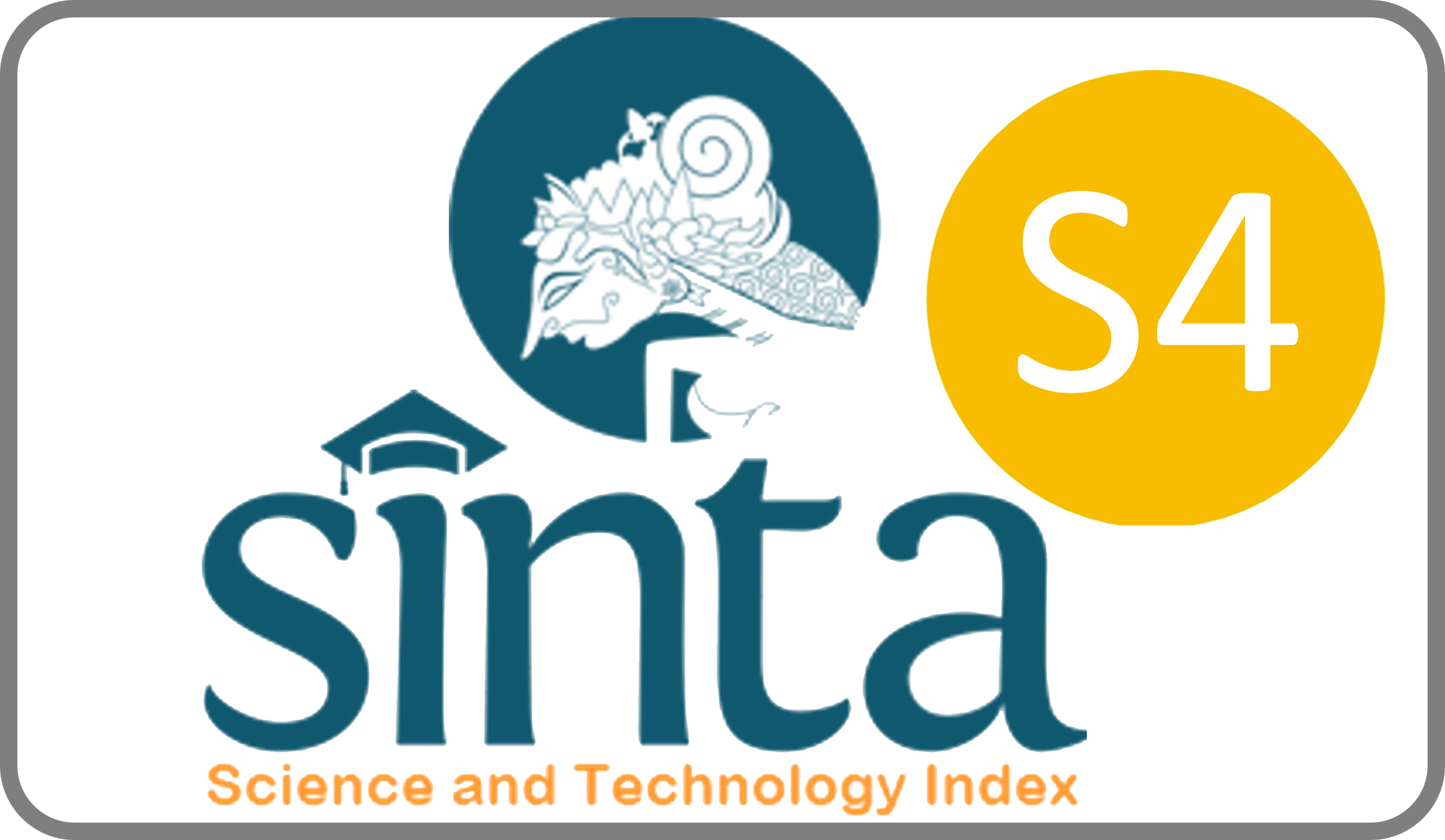ENHANCEMENT OF MOTHERS AND CADRE ROLES IN FIRST 1.000 DAYS OF LIFE AS STUNTING PREVENTION AND DETECTION AT THE MOROKREMBANGAN PRIMARY HEALTH CENTER SURABAYA
Downloads
Stunting is a condition in which children under five years old fail to thrive due to chronic malnutrition in the first 1000 days of life and the height is below the height chart (<-2 SD) on standard age. Although stunting has negative great impact on the child growth and development, parents frequently are not concert about it due to lack of information regarding stunting. The COVID-19 pandemic also contributes on fulfillment of nutritious food, non-routine checks for the child growth and development at the posyandu, and even stopped posyandu activities. Therefore, it is still challenging to detect the incidence of stunting in the community. This program aims to increase the knowledge and raise awareness of the importance of the first 1000 days if life in a child's growth and development also to increase the cadre skill in the early detection of stunting. The community service activity was held in the area of the Morokrembangan Primary Health Center include health promotion and training for early detection of stunting through anthropometric examination for posyandu cadre, pregnancy mother and mother of under 5 years old child. Evaluation was done by measuring the increasing of participants knowledge about stunting through pretest and posttest. There was a significant difference (p = 0.000) between the pretest and posttest. It means that this program activities have succeeded in increasing the knowledge of mothers and cadre. A better understanding of the first 1000 days of life can improve people's behavior to prevent stunting in community.
Aryastami, Ni Ketut. 2017. "Kajian Kebijakan Dan Penanggulangan Masalah Gizi Stunting Di Indonesia.” Buletin Penelitian Kesehatan 45, no. 4: 233–40. https://doi.org/10.22435/bpk.v45i4.7465.233-240.
Atmarita. 2018. "Asupan Gizi Yang Optimal Untuk Mencegah Stunting.” Buletin Jendela, Data Dan Informasi Kesehatan. Pusat Data Dan Informasi. Semester I:1-13.
Azrimaidaliza, Nursal, HA Rahmy, and A Asri. 2019. "Characteristics of Stunted Children Aged 24-36 Months in Padang City.” Malaysian Journal of Public Health Medicine.
Beal, Ty, Alison Tumilowicz, Aang Sutrisna, Doddy Izwardy, and Lynnette M. Neufeld. 2018. "A Review of Child Stunting Determinants in Indonesia.” Maternal and Child Nutrition 14, no. 4: 1–10. https://doi.org/10.1111/mcn.12617.
Ernawati, Dwi, and Diyah Arini. 2020. "Profil Balita Stunting Di Wilayah Kerja Puskesmas Kenjeran Kota Surabaya.” Jurnal Kesehatan Mesencephalon 6, no. 1: 1–10. https://doi.org/10.36053/mesencephalon.v6i1.184.
Febriyanti, Riska, F Nugraha, and Dkk. 2020. Penyuluhan Sosial: Membaca Konteks Dan Memberdayakan Masyarakat. Lekkas. https://books.google.co.id/books?id=cyYMEAAAQBAJ.
Hamzah, St. Rahmawati, and Hamzah B. 2020. "Gerakan Pencegahan Stunting Melalui Edukasi Pada Masyarakat Di Desa Muntoi Kabupaten Bolaang Mongondow.” JPKMI (Jurnal Pengabdian Kepada Masyarakat Indonesia) 1, no. 4: 229–35. https://doi.org/10.36596/jpkmi.v1i4.95.
Indonesia, Kementerian Kesehatan Republik. 2022. Profil Kesehatan Indonesia 2021.
Indonesia, Kementerian Kesehatan RI. 2020. Buku Kesehatan Ibu Dan Anak. Jakarta: Kementerian Kesehatan dan JICA (Japan International Cooperation Agency).
Kakietek, Jakub, Julia Dayton Eberwein Eberwein, Dylan Walters, and Meera Shekar. 2017. "Unleashing Gains in Economic Productivity with Investments in Nutrition.” Washington DC: World Bank Group.
Kemenkes RI. 2018. "Situasi Balita Pendek (Stunting) Di Indonesia.” Buletin Jendela, Data Dan Informasi Kesehatan. Pusat Data Dan Informasi. Kementerian Kesehatan RI 301, no. 5: 1163–78.
Lailatul, Muniroh, and C. Ni'mah. 2015. "Hubungan Tingkat Pendidikan, Tingkat Pengetahuan Dan Pola Asuh Ibu Dengan Wasting Dan Stunting Pada Balita Keluarga Miskin.” Media Gizi Indonesia 10, no. 2015: 84–90. https://doi.org/Vol. 10, No. 1 Januari–Juni 2015: hlm. 84–90 terdiri.
Lamid, A. 2018. "Masalah Kependekan (Stunting) Pada Anak Balita: Analisis Prospek Penanggulangan Di Indonesia.” Buletin Jendela Data Dan Informasi Kesehatan.
Rahmatina, Layalia Azka, and Meira Erawati. 2020. "Evaluasi Program Edukasi Dengan Video Dan Poster Terhadap Perilaku Masyarakat Dalam Menghadapi COVID-19 (Preliminary Study).” Journal of Holistic Nursing and Health Science 3(1): 9–16. https://doi.org/10.14710/hnhs.3.1.2020.9-16.
Rahmawati, Anita, Thatit Nurmawati, and Liliani Permata Sari. 2019. "Faktor Yang Berhubungan Dengan Pengetahuan Orang Tua Tentang Stunting Pada Balita.” Jurnal Ners Dan Kebidanan (Journal of Ners and Midwifery) 6, no. 3: 389–95. https://doi.org/10.26699/jnk.v6i3.art.p389-395.
Sudargo, T. 2018. 1.000 Hari Pertama Kehidupan. Yogyakarta: Gadjah Mada University Press.
Surabaya, Dinas Kesehatan Kota. 2021. Profil Kesehatan Kota Surabaya Tahun 2020.
Copyright (c) 2023 Lucky Prasetiowati, Sulistiawati, Widati Fatmaningrum, Eighty Mardiyan Kurniawati, Hanna Dyahferi Anomsari, Rimbun

This work is licensed under a Creative Commons Attribution-ShareAlike 4.0 International License.
JLM by Unair is licensed under a Creative Commons Attribution-ShareAlike 4.0 International License.
1. The journal allows the author to hold the copyright of the article without restrictions.
2. The journal allows the author(s) to retain publishing rights without restrictions
3. The legal formal aspect of journal publication accessibility refers to Creative Commons Attribution Share-Alike (CC BY-SA).
4. The Creative Commons Attribution Share-Alike (CC BY-SA) license allows re-distribution and re-use of a licensed work on the conditions that the creator is appropriately credited and that any derivative work is made available under "the same, similar or a compatible license”. Other than the conditions mentioned above, the editorial board is not responsible for copyright violation.


















